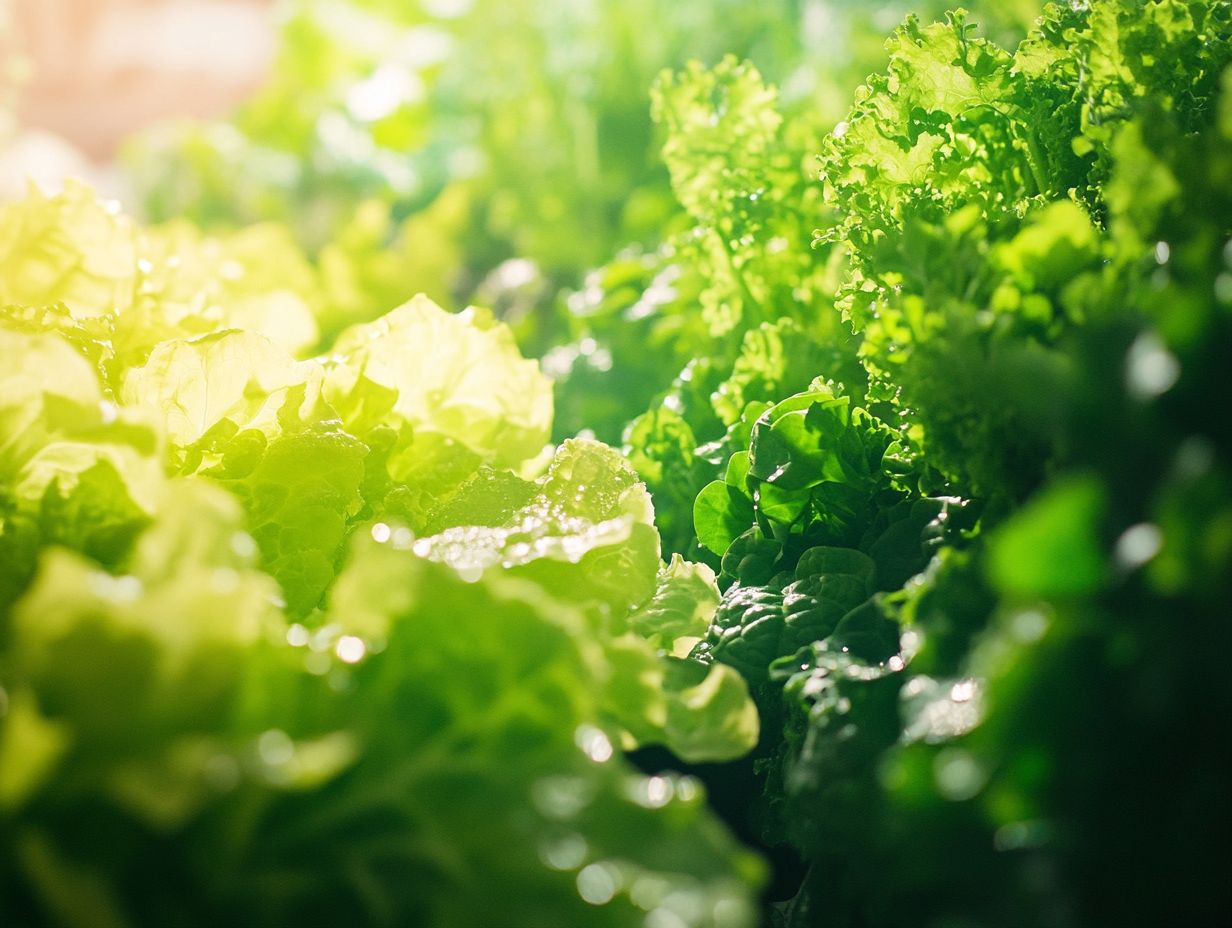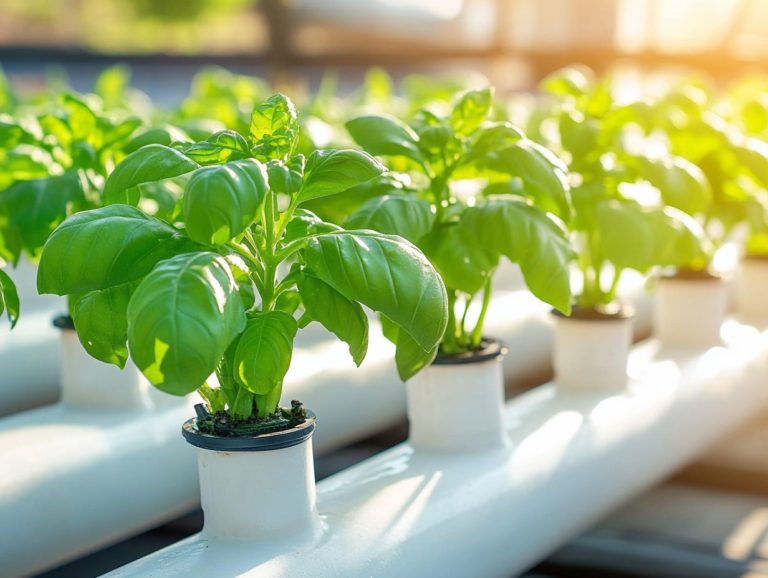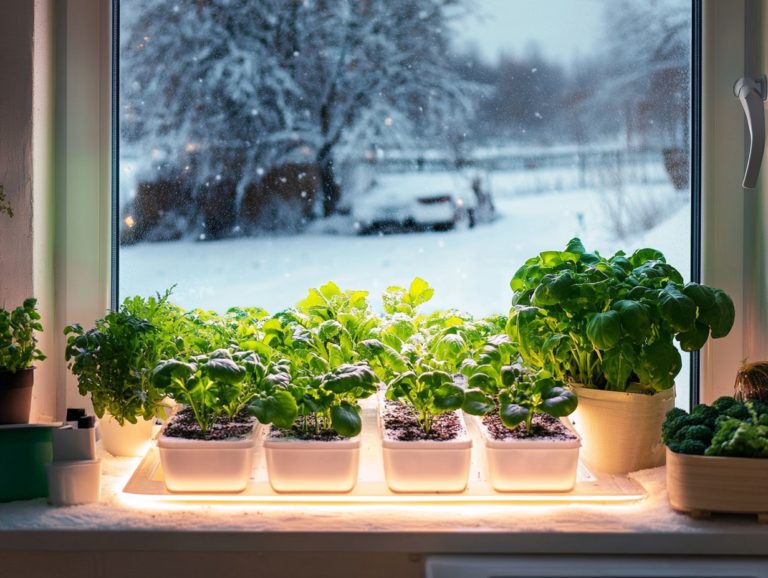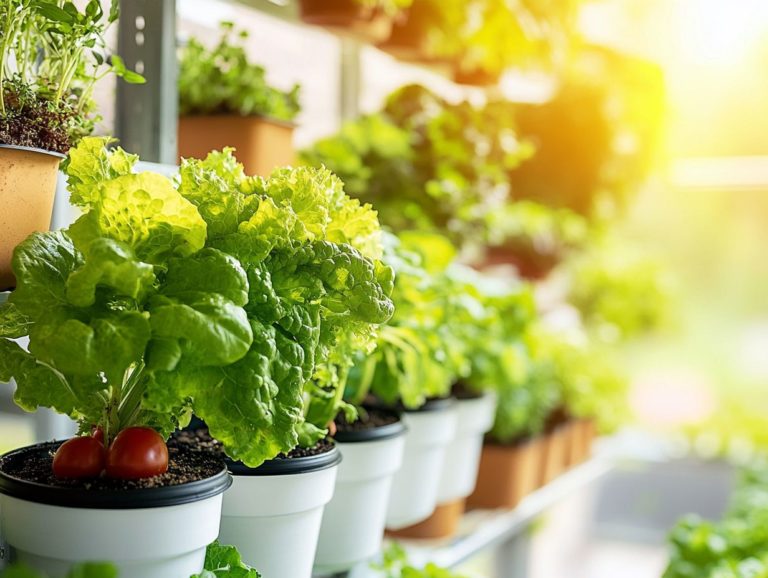“Fast-Growing Hydroponic Greens for Quick Harvests”
Hydroponic gardening is revolutionizing your approach to growing food, presenting a soil-free method that maximizes both space and efficiency.
Discover the ins and outs of hydroponic gardening, including the myriad benefits of cultivating greens this way and the various systems at your disposal. Learn about fast-growing varieties that promise swift harvests, along with their nutritional benefits, ideal growing conditions, and culinary applications.
This guide will navigate you through common pitfalls while offering tips to maximize your yield, ensuring you have everything you need to embark on your hydroponic journey.
Get ready to savor fresh, homegrown greens faster than you ever thought possible!
Contents
- Key Takeaways:
- 1. What Is Hydroponic Gardening?
- 2. Benefits of Growing Hydroponic Greens
- 3. Types of Hydroponic Systems
- 4. Fast-Growing Hydroponic Greens for Quick Harvests
- What Are the Nutritional Benefits of These Greens?
- How Long Does It Take for These Greens to Grow?
- What Are the Ideal Growing Conditions for These Greens?
- How Can These Greens Be Used in Cooking?
- What Are the Most Common Mistakes When Growing These Greens?
- How Can One Maximize Their Harvest of These Greens?
- Are These Greens Suitable for Indoor or Outdoor Hydroponic Gardens?
- What Are the Best Varieties of These Greens to Grow?
- What Are the Potential Challenges When Growing These Greens?
- How Can These Greens Be Stored for Later Use?
- What Are the Different Ways to Incorporate These Greens into a Healthy Diet?
- Are There Any Safety Precautions When Growing These Greens?
- Why Choose Hydroponic Greens? Discover the Environmental Benefits!
- How Can One Get Started with Growing These Greens Hydroponically?
- What Are the Cost Considerations for Growing These Greens Hydroponically?
- Frequently Asked Questions
- What are some examples of fast-growing hydroponic greens for quick harvests?
- Why are fast-growing hydroponic greens ideal for quick harvests?
- What are the benefits of using hydroponics for growing greens?
- How can I ensure a successful harvest with fast-growing hydroponic greens?
- Can fast-growing hydroponic greens be grown in small spaces?
- Are there any disadvantages to growing fast-growing hydroponic greens?
Key Takeaways:

- Hydroponic gardening is a method of growing plants without soil, using nutrient-rich water instead.
- Fast-growing hydroponic greens offer numerous nutritional benefits and can be harvested more quickly than traditional gardening methods.
- Starting a hydroponic garden for growing these greens requires knowledge of the ideal growing conditions, proper maintenance, and cost considerations.
1. What Is Hydroponic Gardening?
Hydroponic gardening is an innovative method that allows you to cultivate plants without soil. This leads to efficient crop production and enhanced nutritional benefits through careful management of nutrients.
This sustainable agriculture technique has become increasingly popular among urban dwellers and commercial growers alike, offering numerous advantages over traditional farming methods.
You ll find benefits such as:
- Hydroponic systems
- Space conservation
- Reduced water usage
- The remarkable ability to grow a variety of crops from leafy greens to fruits in a controlled environment.
Rooted in the ancient practices of the Aztecs and the Hanging Gardens of Babylon, hydroponic methods have evolved significantly thanks to advancements in technology. Unlike traditional gardening, which depends on soil as a substrate, hydroponic systems use nutrient-rich water solutions water mixtures that feed plants to deliver essential elements directly to plant roots.
This approach speeds up crop production and reduces pest-related issues, making it a more efficient choice for modern agriculture.
As awareness of climate change and food security grows, hydroponic gardening is playing a pivotal role in the transition to sustainable practices. It often requires far less land and water compared to conventional farming, making it an essential component in the future of food production.
2. Benefits of Growing Hydroponic Greens
The benefits of growing leafy greens are numerous, providing you with enhanced nutritional benefits, faster growth rates, and a sustainable agriculture approach that’s becoming increasingly essential in today s food landscape.
With hydroponic farming, you can enjoy year-round production of leafy greens like spinach, kale, collard greens, butterhead lettuce, arugula, green oak, red oak, and romaine lettuce in optimized conditions. This leads to higher yields and better resource management compared to traditional soil-based methods.
Not only does this innovative technique conserve water and land resources, but it also boosts the efficiency of food production, making it a perfect fit for urban settings where space is at a premium.
By minimizing the land required for cultivation, hydroponics paves the way for local food systems, giving communities easier access to fresh produce with reduced transportation needs.
Nutritionally speaking, these greens often pack a punch with higher vitamin and mineral concentrations, including mustard greens and rainbow chard, as they can be harvested at their peak. This enhances the overall health of individuals who include them in their diets.
Furthermore, the rapid growth cycles inherent to hydroponics bolster food security, ensuring a steady supply of high-quality nutrients, no matter the external environmental conditions.
3. Types of Hydroponic Systems
There are several types of hydroponic systems designed to optimize plant growth. They deliver a nutrient solution directly to the roots.
Systems like deep water culture and nutrient film technique give you precise control over environmental factors. This enhances the yield of your crops.
A standout option is the Ebb and Flow method, especially for strawberry cultivation. It periodically floods plants, making it perfectly suited for leafy greens with shallow roots.
Keep in mind that pump failure could lead to root dehydration, so monitor it closely.
The Wick system is simple and low-maintenance, making it great for beginners and herbs. However, it may not provide enough nutrients for larger plants.
The Nutrient Film Technique suits quick-growing crops like strawberries. It ensures continuous nutrient flow for impressive growth but requires careful management of nutrient concentration and oxygen levels.
Each system has its strengths and weaknesses. Choose the right method based on your crop’s specific needs for optimal results.
4. Fast-Growing Hydroponic Greens for Quick Harvests
Fast-growing hydroponic greens like arugula, butterhead lettuce, collard greens, and various lettuce types, including green oak and red oak, offer quick harvests. They are perfect whether you’re a novice or a seasoned grower.
These leafy greens flourish in hydroponic systems, easily adapting to soil-less environments. This method also allows for culinary pairings that enhance their taste.
Their rapid growth cycles can range from just a few weeks to a month, depending on the variety and conditions. These greens generally prefer bright, indirect light, thriving on around 12 to 16 hours of light daily.
For optimal development, use nutrient-rich water solutions that maintain a perfect balance, including nitrogen, phosphorus, and potassium.
To maximize yields, maintain consistent temperature and humidity levels in your growing area. These greens can elevate your salads, sandwiches, and smoothies.
They pair beautifully with ingredients like olive oil, lemon juice, and a range of cheeses, enhancing both flavor and nutrition.
What Are the Nutritional Benefits of These Greens?
The nutritional benefits of hydroponic greens, including basil, cilantro, and fennel, are impressive. They offer essential vitamins and minerals that play a crucial role in maintaining a balanced diet while being lower in calories than many conventional crops.
Leafy greens like kale, spinach, and rainbow chard are abundant in antioxidants and vitamins A, C, and K, making them exceptional choices for health-conscious individuals.
These nutrient-rich greens do more than just taste good; they support your immune system and promote eye health. They also provide a high fiber content that aids digestion and keeps you feeling full.
Hydroponic methods can enhance these benefits. Without soil, plants receive customized nutrient solutions that boost their vitamin levels and overall quality.
By choosing hydroponically grown greens like thyme, rosemary, or peppermint, you’re opting for fresher produce with superior nutritional profiles, often featuring higher concentrations of beneficial compounds.
This cultivation method also reduces exposure to pesticides and environmental contaminants, making it an attractive option for those seeking cleaner, more sustainable food sources.
How Long Does It Take for These Greens to Grow?

The growth cycle of hydroponic greens varies by crop. Many leafy greens are ready for harvest in as little as 4 to 6 weeks under optimal conditions. Understanding the expected growth times for specific greens, such as arugula, spinach, and kale, is essential for effective planning and yield management.
Factors like light intensity, nutrient levels, and temperature play a significant role in enhancing plant growth. For example, arugula thrives in cooler temperatures and can yield quickly, often being ready in about 4 weeks. Spinach and kale generally take longer to grow, typically needing around 5 to 7 weeks.
Ensuring that your nutrient solution is well-balanced and tailored to the plants’ needs is crucial. Deficiencies or excesses can slow growth. Maintaining optimal light exposure around 12 to 16 hours a day can significantly influence how often you can harvest. By adjusting these parameters, you can create ideal conditions that lead to more frequent and bountiful yields.
What Are the Ideal Growing Conditions for These Greens?
To achieve optimal growth, hydroponic greens demand specific growing conditions, such as controlled temperature, humidity, and light exposure, which vary among leafy greens like romaine lettuce, mustard greens, and collard greens. Crafting the right environment enhances not only growth rates but also the flavor and nutritional content of your crops.
For example, romaine lettuce flourishes best in temperatures between 60 and 70 F, with humidity levels hovering around 50-70%. Mustard greens prefer slightly warmer conditions, around 65 to 75 F. Adequate light is essential, ideally 12-16 hours a day, to support their development. Implementing systems like deep water culture or nutrient film technique can efficiently maintain these optimal conditions.
By adjusting water temperatures, managing air circulation, and utilizing grow lights that simulate natural sunlight, you can profoundly influence the health and yield of your hydroponic greens. Staying attentive to these critical factors ensures a thriving crop that meets both taste and quality standards.
How Can These Greens Be Used in Cooking?
Hydroponic greens open up exciting culinary possibilities! Use them to elevate your dishes, from fresh spinach salads to gourmet wraps filled with collard greens. These leafy wonders are easily woven into your everyday meals, offering delightful flavors and a wealth of nutritional benefits.
With their crisp textures and vibrant colors, hydroponic greens can transform grain bowls by pairing quinoa or farro with lightly saut ed arugula and grilled chicken. You might even consider blending them into smoothies, combining them with fruit for a refreshing morning lift.
To keep these greens fresh, store them in perforated bags in the refrigerator or use a produce container to maintain their delightful crispness. Don t miss out on the chance to enjoy these greens! Get creative in the kitchen today steaming or quick stir-frying can enhance their unique flavors while ensuring they retain their valuable nutrients.
What Are the Most Common Mistakes When Growing These Greens?
When growing hydroponic greens, you might encounter common pitfalls such as improper nutrient solution ratios, insufficient lighting, and neglecting environmental factors like temperature and humidity. These oversights can drastically affect your growth and yield. Acknowledging these challenges is vital, whether you re a novice or a seasoned grower.
To ensure your plants thrive, regularly testing and adjusting your nutrient solutions is essential. This means maintaining the right pH and EC levels (Electrical Conductivity, indicating nutrient concentration) tailored to the specific plants you re cultivating. Adequate lighting, with the appropriate spectra and duration, can significantly boost photosynthesis.
Implementing timers for your lights and utilizing climate control systems can help you manage temperature fluctuations and humidity levels, fostering a flourishing hydroponic ecosystem.
How Can One Maximize Their Harvest of These Greens?
Maximize your harvest of hydroponic greens with strategic planting schedules and precise nutrient management. Learn the growth patterns of leafy greens for continuous harvests.
Adjusting your planting intervals enables staggered harvests. While one batch is being picked, another is maturing right on schedule. A well-timed nutrient plan can significantly boost plant health and yield, ensuring your greens receive the ideal balance of nitrogen, phosphorus, and potassium at each growth stage.
It’s crucial to monitor factors like light, temperature, and humidity to cultivate the perfect growth atmosphere. Integrating crop rotation, which involves changing what you plant in a specific area to keep the soil healthy, and companion planting, where you grow different plants together to benefit each other, enriches your hydroponic setup.
Are These Greens Suitable for Indoor or Outdoor Hydroponic Gardens?
Hydroponic greens are incredibly versatile, thriving in both indoor and outdoor gardens tailored to meet the specific needs of the plants and your resources. If you opt for an indoor setup, you can enjoy year-round cultivation of delicious greens like kale and spinach.
Meanwhile, outdoor systems can take full advantage of natural sunlight and environmental elements, promoting robust growth. Both options offer exciting benefits and some challenges to navigate.
Indoor hydroponics grants you enhanced control over factors like temperature, humidity, and light, often resulting in higher yields. However, outdoor gardening can dramatically cut operational costs, benefiting from abundant sunlight and natural conditions that encourage vigorous plant development.
To truly maximize your growth potential, invest in high-quality grow lights and a reliable temperature regulation system for your indoor garden. If you’re leaning toward outdoor gardening, focus on selecting the ideal location that captures ample sunlight while offering protection from harsh weather conditions.
What Are the Best Varieties of These Greens to Grow?

The finest hydroponic greens to cultivate often include fast-growing varieties like arugula, butterhead lettuce, and spinach. These greens thrive in controlled environments and promise a quick turnaround for harvests.
Choosing the right varieties can significantly influence your success in hydroponic gardening and the nutritional quality of your produce. By considering growth characteristics such as growth rate, temperature tolerance, and potential yields, you can optimize your selections.
For example, arugula brings a peppery punch, making it ideal for lively salads. Butterhead lettuce offers a sweet, buttery flavor that elevates sandwiches and wraps. Spinach, with its remarkable versatility, can find its way into everything from smoothies to hearty dishes.
When selecting hydroponic greens, reflect on your culinary preferences while also considering market demands. This dual approach ensures a harvest that delights both your taste buds and potential consumers.
Start planning your hydroponic garden today for a fresh and delicious harvest tomorrow!
What Are the Potential Challenges When Growing These Greens?
Growing hydroponic greens has many benefits, but it also poses challenges. Key issues include managing diseases and maintaining the right nutrient balance.
Pests and diseases can disrupt your operation quickly. For example, aphids or powdery mildew can spread rapidly, affecting your harvest.
System failures, like pump malfunctions or poor water quality, also require immediate attention. These risks can be serious.
To reduce these risks, implement preventative measures:
- Regularly check your system
- Keep pH levels stable
- Use beneficial insects for pest control
A clean workspace boosts crop health and reduces disease spread. This creates a more successful hydroponic garden.
How Can These Greens Be Stored for Later Use?
Properly storing hydroponic greens is essential to keep them fresh and nutritious. Techniques like refrigeration, vacuum sealing, and using the right packaging can greatly extend their shelf life.
Store your greens in a cool, dark place. The refrigerator should be set between 32 and 36 degrees Fahrenheit.
Use breathable packaging, like perforated plastic bags or cloth, to retain moisture without condensation. A paper towel inside the bag can help absorb excess moisture.
Avoid ethylene-producing fruits to keep your greens fresh. By using these easy tips, you’ll enjoy your hydroponic produce for longer.
What Are the Different Ways to Incorporate These Greens into a Healthy Diet?
Incorporating hydroponic greens into your diet is easy and versatile. You can create vibrant salads, energizing smoothies, and satisfying main dishes.
Add these greens to your breakfast bowls for a nutritious start, or stir them into hearty soups for extra vitamins. They make a great base for wraps and sandwiches, pairing perfectly with proteins and other vegetables.
For lunch, toss hydroponic greens in a grain salad with legumes and mustard greens for a filling meal. At dinner, saut them with garlic and olive oil for a delicious side.
Explore these meal ideas and embrace the benefits of hydroponic greens. They can enrich your diet and support a passion for fresh, sustainable food.
Are There Any Safety Precautions When Growing These Greens?
When growing hydroponic greens without soil, it’s crucial to prioritize safety precautions to ensure a healthy crop and protect your well-being. This involves proper sanitation, effective pest management, and safe handling of nutrient solutions.
Understanding these measures will help you minimize risks associated with hydroponic farming and optimize your growing environment. By incorporating strict hygiene practices, like regular cleaning and disinfecting of your equipment, you can prevent harmful pathogens that could jeopardize your yield.
Effective chemical handling protocols such as using gear like gloves and masks that keeps you safe while handling materials and sticking to recommended dosage guidelines will help you mitigate dangers linked to fertilizers and pesticides, especially in crop production.
Implementing proactive pest control strategies, like monitoring for infestations and using organic solutions, will bolster your plants’ health, including arugula and rainbow chard, while ensuring your safety as a grower. By adhering to these essential practices, you can confidently grow vibrant crops that impress everyone and maintain a secure growing atmosphere.
Why Choose Hydroponic Greens? Discover the Environmental Benefits!
Growing hydroponic greens presents you with a multitude of environmental advantages. You’ll find reduced water usage, diminished dependence on pesticides, and the opportunity to cultivate food in urban settings, including strawberry cultivation, all championing sustainable agricultural practices.
This innovative method conserves precious resources and mitigates land degradation, positioning itself as a viable solution for future food security. Hydroponic farming allows you to maximize space efficiently, enabling cultivation in locations where traditional farming might be impractical think rooftops or repurposed warehouses.
By harnessing nutrient-rich water systems, this approach significantly reduces the risk of runoff pollution, safeguarding surrounding ecosystems from harmful chemicals commonly associated with conventional agriculture. It tackles water scarcity head-on through precise water management techniques, ensuring that only the necessary amount of water is utilized for crops like collard greens and fennel.
In these compelling ways, hydroponics confronts immediate environmental challenges and plays a crucial role in the long-term sustainability of global food systems. Ready to join the hydroponic revolution and grow your greens today?
How Can One Get Started with Growing These Greens Hydroponically?

Getting started with growing hydroponic greens is an exciting venture. Fast-growing varieties like spinach and butterhead lettuce are perfect for beginners.
Select the right hydroponic system and understand the specific needs of leafy greens. Prepare the necessary supplies for a successful cultivation experience.
With the rising interest in home gardening and sustainable agriculture, including growing herbs like rosemary and thyme, a wealth of resources can guide you through the process.
To embark on this journey, choose among various hydroponic systems:
- Deep Water Culture: A simple method where roots are submerged in nutrient-rich water.
- Nutrient Film Technique: A thin film of nutrients flows over the roots.
- Ebb and Flow: Flood and drain cycles nourish the plants.
Each option caters to different skill levels and space constraints. Even the cultivation of cucumbers can fit into your growing plan, so pick one that aligns with your situation.
Gather essential equipment like grow lights, a pH meter (a device used to measure acidity levels in water), and nutrient solution for optimal growth. Set up your system, then balance the water temperature and pH.
Sow seeds in net pots lined with growing medium to set off on a smooth path for crops such as basil and rainbow chard.
For those eager to dive deeper, including discussions on hydroponic systems for fruits like strawberries, online forums and gardening workshops provide valuable insights and troubleshooting tips. Your hydroponic experience can be both successful and rewarding!
What Are the Cost Considerations for Growing These Greens Hydroponically?
Cost considerations for growing hydroponic greens can vary based on the scale of your operation, the type of hydroponic system you choose, and ongoing expenses related to nutrients and maintenance.
Initial setup costs may include purchasing equipment like grow lights, pumps, and nutrient reservoirs. These expenses can significantly impact your budget and the success of crops like green oak and fennel.
While small home systems might have modest entry costs, larger commercial setups often demand significant investments in infrastructure.
Don’t overlook ongoing maintenance expenses! These include replacing carbon filters, covering electricity for lighting, and replenishing nutrient solutions. These are vital components of the financial equation, especially for strawberry cultivation.
It’s wise to develop a comprehensive budget that covers all these elements. This includes potential expenses for herbs such as oregano and peppermint. Careful planning and efficient resource management will help maximize your returns on investment.
Proper budgeting will give you a clearer picture of how long it might take for your operation to become profitable. This empowers you to make informed decisions every step of the way.
Frequently Asked Questions
What are some examples of fast-growing hydroponic greens for quick harvests?
Examples of fast-growing greens are romaine lettuce, butterhead lettuce, spinach, kale, arugula, and mustard greens.
Why are fast-growing hydroponic greens ideal for quick harvests?
Fast-growing hydroponic greens, such as mustard greens and rainbow chard, can mature in half the time it takes for traditional soil-grown greens. This makes them perfect for quick harvests!
What are the benefits of using hydroponics for growing greens?
Hydroponic systems offer more control over nutrient levels and water supply, including optimal nutrient solutions. This results in faster and healthier plant growth. They also require less space and can be grown year-round, accommodating a variety of crops from celery to cucumbers.
How can I ensure a successful harvest with fast-growing hydroponic greens?
Regularly check the pH levels and nutrient solution of your hydroponic system. This helps maintain the best conditions for your leafy greens.
Provide adequate light and ventilation for your plants. This includes herbs like thyme and rosemary.
Can fast-growing hydroponic greens be grown in small spaces?
Yes! Hydroponic systems can fit perfectly in small spaces like apartments or balconies.
Vertical systems are a great option to maximize your space for growing herbs like oregano and fennel.
Are there any disadvantages to growing fast-growing hydroponic greens?
Hydroponic greens, such as kale and collard greens, may grow faster and healthier than those in soil. However, they can be more expensive to set up and maintain.
You will need some knowledge and skill to manage the system effectively. Don t miss out on the chance to enjoy fresh greens at home!






